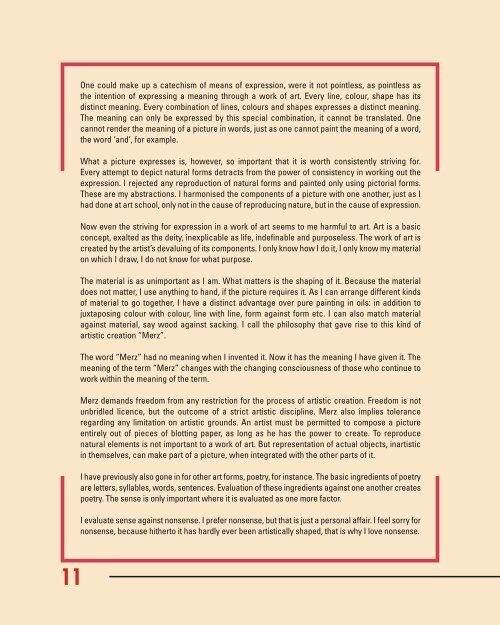Kurt Schwitters: Merz (2016) – Norman Rosenthal interviews Damien Hirst
Fully illustrated catalog published by Galerie Gmurzynska in collaboration with Cabaret Voltaire Zurich on the occasion of Kurt Schwitters: MERZ, a major retrospective exhibition celebrating 100 years of Dada. The exhibition builds and expands on the gallery’s five decade long exhibition history with the artist, featuring exhibition architecture by Zaha Hadid. Edited by Krystyna Gmurzynska and Mathias Rastorfer. First of three planned volumes containing original writings by Kurt Schwitters, historical essays by Ernst Schwitters, Ad Reinhardt and Werner Schmalenbach as well as text contributions by Siegfried Gohr, Adrian Notz, Jonathan Fineberg, Karin Orchard, and Flavin Judd. Foreword by Krystyna Gmurzynska and Mathias Rastorfer. Interview with Damien Hirst conducted by Norman Rosenthal. Includes full color plates and archival photographs. 174 pages, color and b/w illustrations. English. ISBN: 978-3-905792-33-1 The publication includes an Interview with Damien Hirst by Sir Norman Rosenthal about the importance of Kurt Schwitters's practice for Hirst's work.
Fully illustrated catalog published by Galerie Gmurzynska in collaboration with Cabaret Voltaire Zurich on the occasion of Kurt Schwitters: MERZ, a major retrospective exhibition celebrating 100 years of Dada. The exhibition builds and expands on the gallery’s five decade long exhibition history with the artist, featuring exhibition architecture by Zaha Hadid.
Edited by Krystyna Gmurzynska and Mathias Rastorfer.
First of three planned volumes containing original writings by Kurt Schwitters, historical essays by Ernst Schwitters, Ad Reinhardt and Werner Schmalenbach as well as text contributions by Siegfried Gohr, Adrian Notz, Jonathan Fineberg, Karin Orchard, and Flavin Judd.
Foreword by Krystyna Gmurzynska and Mathias Rastorfer.
Interview with Damien Hirst conducted by Norman Rosenthal.
Includes full color plates and archival photographs.
174 pages, color and b/w illustrations.
English.
ISBN:
978-3-905792-33-1
The publication includes an Interview with Damien Hirst by Sir Norman Rosenthal about the importance of Kurt Schwitters's practice for Hirst's work.
Create successful ePaper yourself
Turn your PDF publications into a flip-book with our unique Google optimized e-Paper software.
One could make up a catechism of means of expression, were it not pointless, as pointless as<br />
the intention of expressing a meaning through a work of art. Every line, colour, shape has its<br />
distinct meaning. Every combination of lines, colours and shapes expresses a distinct meaning.<br />
The meaning can only be expressed by this special combination, it cannot be translated. One<br />
cannot render the meaning of a picture in words, just as one cannot paint the meaning of a word,<br />
the word ‘and’, for example.<br />
What a picture expresses is, however, so important that it is worth consistently striving for.<br />
Every attempt to depict natural forms detracts from the power of consistency in working out the<br />
expression. I rejected any reproduction of natural forms and painted only using pictorial forms.<br />
These are my abstractions. I harmonised the components of a picture with one another, just as I<br />
had done at art school, only not in the cause of reproducing nature, but in the cause of expression.<br />
Now even the striving for expression in a work of art seems to me harmful to art. Art is a basic<br />
concept, exalted as the deity, inexplicable as life, indefinable and purposeless. The work of art is<br />
created by the artist’s devaluing of its components. I only know how I do it, I only know my material<br />
on which I draw, I do not know for what purpose.<br />
The material is as unimportant as I am. What matters is the shaping of it. Because the material<br />
does not matter, I use anything to hand, if the picture requires it. As I can arrange different kinds<br />
of material to go together, I have a distinct advantage over pure painting in oils: in addition to<br />
juxtaposing colour with colour, line with line, form against form etc. I can also match material<br />
against material, say wood against sacking. I call the philosophy that gave rise to this kind of<br />
artistic creation “<strong>Merz</strong>”.<br />
The word “<strong>Merz</strong>” had no meaning when I invented it. Now it has the meaning I have given it. The<br />
meaning of the term “<strong>Merz</strong>” changes with the changing consciousness of those who continue to<br />
work within the meaning of the term.<br />
<strong>Merz</strong> demands freedom from any restriction for the process of artistic creation. Freedom is not<br />
unbridled licence, but the outcome of a strict artistic discipline. <strong>Merz</strong> also implies tolerance<br />
regarding any limitation on artistic grounds. An artist must be permitted to compose a picture<br />
entirely out of pieces of blotting paper, as long as he has the power to create. To reproduce<br />
natural elements is not important to a work of art. But representation of actual objects, inartistic<br />
in themselves, can make part of a picture, when integrated with the other parts of it.<br />
I have previously also gone in for other art forms, poetry, for instance. The basic ingredients of poetry<br />
are letters, syllables, words, sentences. Evaluation of these ingredients against one another creates<br />
poetry. The sense is only important where it is evaluated as one more factor.<br />
I evaluate sense against nonsense. I prefer nonsense, but that is just a personal affair. I feel sorry for<br />
nonsense, because hitherto it has hardly ever been artistically shaped, that is why I love nonsense.<br />
11

















